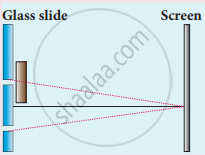Advertisements
Advertisements
प्रश्न
In Young’s double slit experiment, the slits are separated by 0.5 mm and screen is placed 1.0 m away from the slit. It is found that the 5th bright fringe is at a distance of 4.13 mm from the 2nd dark fringe. Find the wavelength of light used.
उत्तर
Given d = 0.5mm
D = 1.0m
5th bright `x_n = ( n lambda D ) / d`
`x_5 = 5 ( lambda D) /d`
2nd dark `x_m = (2m-1) (lambdaD)/(2d)`
`5(lambdaD)/(d) = (3 lambdaD)/(2d) = 4.13 xx 10^(-3) ⇒ ( 7lambdaD)/(2d) = 4.13 xx 10^(-3)`
`(7lambda xx 1)/(2 xx5 xx10^(-4)) = 4.13 xx 10^(-3) lambda = (2 xx 4.13 xx 10^(-3) xx 5 xx 10^(-4))/7`
`lambda = 5.9 xx 10^(-7) m`
APPEARS IN
संबंधित प्रश्न
A double-slit arrangement produces interference fringes for sodium light (λ = 589 nm) that are 0.20° apart. What is the angular fringe separation if the entire arrangement is immersed in water (n = 1.33)?
Draw a neat labelled ray diagram of the Fresnel Biprism experiment showing the region of interference.
What is interference?
One of Young’s double slits is covered with a glass plate as shown in figure. The position of central maximum will,

In Young's double slit experiment green light is incident on the two slits. The interference pattern is observed on a screen. Which one of the following changes would cause the observed fringes to be more closely spaced?
A thin mica sheet of thickness 4 x 10-6 m and refractive index 1.5 is introduced in the path of the first wave. The wavelength of the wave used is 5000 A. The central bright maximum will shift ______.
In Young's double slit experiment fifth dark fringe is formed opposite to one of the slits. If D is the distance between the slits and the screen and d is the separation between the slits, then the wavelength of light used is ______.
In biprism experiment, the 4th dark band is formed opposite to one of the slits. The wavelength of light used is ______.
A beam of electrons is used in Young's double-slit experiment. If the speed of electrons is increased then the fringe width will ______.
In biprism experiment, the distance of 20th bright band from the central bright band is 1.2 cm. Without changing the experimental set-up, the distance of 30th bright band from the central bright band will be ______.
